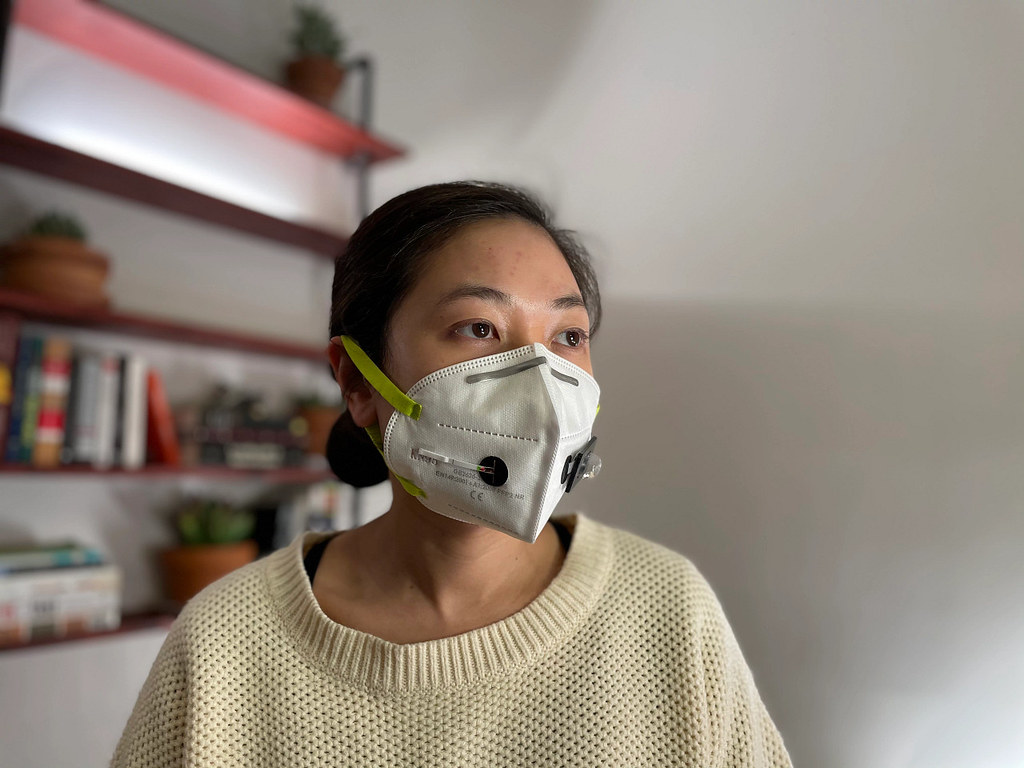哈佛大學Wyss生物啟發工程研究所和麻省理工學院(MIT)科學家們,成功將生物合成感測器嵌入織物,開發出穿戴式生物感測裝置,還可以程式編寫以檢測病原體和毒素,並透過手機app提醒佩戴者。

感測器可應用於口罩上 90分鐘內提供檢測結果
研究團隊已將該技術應用於標準口罩,以檢測患者呼吸中是否有新冠病毒存在。
按下口罩按鈕後,可在90分鐘內提供檢測結果,準確度與標準核酸診斷測試相當,包括聚合酶連鎖反應(PCR)。該成果發表在6月28日的《自然:生物科技(Nature Biotechnology)》期刊。
「基本上就是將整個診斷實驗室縮小到一個小型生物合成感測器上,可搭配任何口罩使用,並結合PCR測試的精準度與抗原測試的速度和低成本,」研究第一作者、Wyss研究所科學家阮彼得(Peter Nguyen)博士說,「除了口罩,我們的可編程生物感測器還可以整合到其他的服裝上,隨時檢測病毒、細菌、毒素和化學製劑等危險物質。」
該技術的核心是將細胞用於讀取DNA並產生RNA和蛋白質的分子機制提取和冷凍乾燥起來。這些生物元素可長時間保持穩定,加水就能啟動活性。
此生物感測器可加上合成遺傳迴路,偵測到目標分子時便能發出訊號。
「這項技術可以應用在研究危險材料或病原體的實驗室外套、醫生和護理師的手術服,或者可能暴露於危險病原體或毒素(如神經毒氣)的急救人員和軍事人員制服。」另一位共同作者、Wyss研究所科學家東雅( Nina Donghia)說。

疫情爆發後 科學家將研究重心從穿戴裝置移至口罩
研究人員最初將這項技術整合在診斷2015年茲卡病毒的工具上。他們將生物感測器編程成可檢測病原體衍生RNA,並與有色或熒光指示蛋白結合,最後嵌入遺傳迴路於試紙,開發出低成本、準確、便攜的診斷工具。
接著科學團隊想利用這個技術開發穿戴裝置。
「過去已經有研究團隊開發出可感測生物分子的穿戴裝置,但這些技術都需要將活細胞放入可穿戴設備,使用者就像戴著一個小水族箱一樣。萬一水族箱損壞,其中的生物可能會洩漏到穿戴者身上。」阮博士說。
他和同事開始研究他們的技術是否可以解決這個問題,並在100多種不同的織物上中進行測試。
這個新冠病毒生物感測器是「穿戴式冷凍乾燥無細胞(wFDCF)技術」團隊三年來的工作成果。該技術以Wyss資深科學家、麻省理工學院醫學工程與科學教授柯林斯(Jim Collins)博士的研究為基礎。
去年COVID-19來襲,科學團隊的工作重心便從一般的可穿戴設備轉向口罩。從2020年5月開始,整個研究計畫在隔離或嚴格的社交距離之下完成。
口罩上「穿戴式冷凍乾燥無細胞(wFDCF)技術」運作原理
最終產品由三種不同的冷凍生物反應組成,只需按一下按鈕,即可釋出水份來依序啟動這些反應。
第一個反應是切開新冠病毒的膜以暴露其RNA。第二個反應是一個擴大步驟,從病毒RNA生成大量的雙鏈棘突基因副本。最後一個反應使用以CRISPR為基礎的SHERLOCK技術來檢測棘突基因片段,並將探針分子切成兩個較小的片段,然後透過側向流檢測條顯示檢測結果。
是否能進行最後一個步驟,視穿戴者呼吸之中是否帶有新冠病毒而定。若感測到新冠病毒,wFDCF系統會切斷分子鍵,改變顯示區中的線條數量,就像驗孕棒的讀取方式。
現在該團隊正積極尋找有興趣幫助大規模生產口罩診斷工具,以及檢測其他生物和環境危害的製造合作夥伴。

Scientists have found a way to embed synthetic biology-based sensors into fabrics, creating wearable biosensors that can be programmed to detect pathogens and toxins and to alert the wearer via a companion smartphone app.
The team from the Wyss Institute for Biologically Inspired Engineering at Harvard University and the Massachusetts Institute of Technology has integrated this technology into standard face masks to detect the presence of the SARS-CoV-2 virus in a patient’s breath.
The button-activated mask gives results within 90 minutes at levels of accuracy comparable to standard nucleic acid-based diagnostic tests like polymerase chain reactions, known informally as PCR. The achievement is reported in the June 28 issue of the journal “Nature Biotechnology.”
“We have essentially shrunk an entire diagnostic laboratory down into a small, synthetic biology-based sensor that works with any face mask, and combines the high accuracy of PCR tests with the speed and low cost of antigen tests,” said co-first author Peter Nguyen, PhD, a research scientist at the Wyss Institute.
“In addition to face masks,” Dr. Nguyen said, “our programmable biosensors can be integrated into other garments to provide on-the-go detection of dangerous substances including viruses, bacteria, toxins, and chemical agents.”
The technique involves extracting and freeze-drying the molecular machinery that cells use to read DNA and produce RNA and proteins. These biological elements are shelf-stable for long periods of time and activating them is simple: just add water.
Synthetic genetic circuits can be added to create biosensors that can produce a detectable signal in response to the presence of a target molecule.
“This technology could be incorporated into lab coats for scientists working with hazardous materials or pathogens, scrubs for doctors and nurses, or the uniforms of first responders and military personnel who could be exposed to dangerous pathogens or toxins, such as nerve gas,” said co-author Nina Donghia, a staff scientist at the Wyss Institute.
The researchers first applied this technology to diagnostics by integrating it into a tool to address the Zika virus outbreak in 2015. They created biosensors that can detect pathogen-derived RNA molecules and coupled them with a colored or fluorescent indicator protein, then embedded the genetic circuit into paper to create a cheap, accurate, portable diagnostic.
Following their success embedding their biosensors into paper, the team of scientists next set their sights on making them wearable.
“Other groups have created wearables that can sense biomolecules, but those techniques have all required putting living cells into the wearable itself, as if the user were wearing a tiny aquarium. If that aquarium ever broke, then the engineered bugs could leak out onto the wearer, and nobody likes that idea,” said Dr. Nguyen.
He and his teammates started investigating whether their technology could solve this problem, testing it in more than 100 different kinds of fabrics.
The SARS-CoV-2 biosensor is the culmination of three years of work on what the team calls their wearable freeze-dried cell-free, wFDCF, technology, which is built upon earlier versions created in the lab of Wyss Core Faculty member and senior author Jim Collins, PhD, a professor of medical engineering and science at MIT.
Then, the COVID-19 pandemic struck and the scientific team pivoted from wearables in general to focus on face masks.
The entire project was done under quarantine or strict social distancing starting in May 2020.
How These Face Masks Work
The final product consists of three different freeze-dried biological reactions that are sequentially activated by the release of water from a reservoir with the single push of a button.
When SARS-CoV-2 particles are present, the wFDCF system cuts a molecular bond that changes the pattern of lines that form in the readout strip, similar to an at-home pregnancy test.
The first reaction cuts open the SARS-CoV-2 virus’ membrane to expose its RNA. The second reaction is an amplification step that makes numerous double-stranded copies of the Spike-coding gene from the viral RNA. The final reaction uses CRISPR-based SHERLOCK technology to detect any Spike gene fragments, and in response cut a probe molecule into two smaller pieces that are then reported via a lateral flow assay strip.
Whether or not there are any Spike fragments available to cut depends on whether the patient has SARS-CoV-2 in their breath.
This is reflected in changes in a simple pattern of lines that appears on the readout portion of the device, similar to an at-home pregnancy test.
Now, the team is actively searching for manufacturing partners who are interested in helping to enable the mass production of the face mask diagnostic for use during the COVID-19 pandemic, as well as for detecting other biological and environmental hazards.
※ 全文及圖片詳見:ENS







